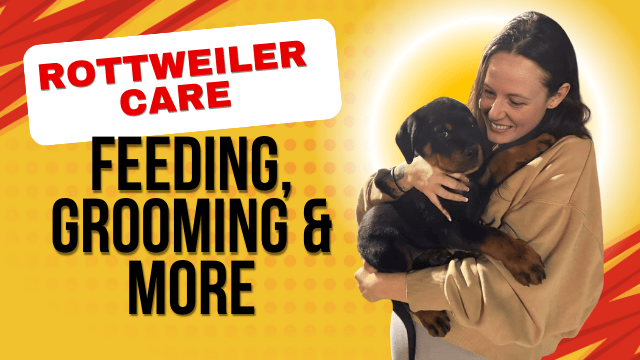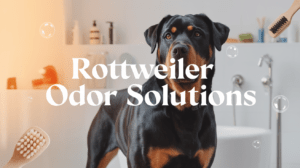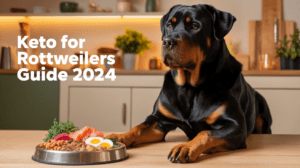-
Rottweiler care is a lifelong commitment that involves meeting their physical and emotional needs throughout different life stages.
-
Proper nutrition is crucial, with specific dietary requirements for puppies, adults, and senior dogs.
-
Regular grooming is essential to manage shedding, maintain a healthy coat, and prevent skin and ear problems.
-
Early training and socialization are vital for raising a well-behaved and well-adjusted Rottweiler.
-
Building a strong bond with your Rottweiler through consistent care and attention creates a fulfilling and rewarding relationship.
In this guide, we’ll cover everything you need to know about caring for a Rottweiler, from those clumsy puppy days to their golden years. We’ll tackle those drool puddles, conquer the fur storms, and equip you with the knowledge to keep your Rottie thriving. Think of it as your cheat sheet to a happy, healthy, and (maybe) slightly less drool-covered Rottie!
Puppyhood: Those Adorable Land Sharks (Concise and Structured)
Ah, puppyhood! Those tiny Rottweiler paws, that playful energy, and those needle-sharp puppy teeth that seem to find their way into everything. It’s a time of joy, discovery, and… a whole lot of chaos. But amidst all the puppy antics, it’s crucial to lay the foundation for a healthy life.
Feeding Your Growing Rottie:
Those adorable Rottweiler pups might look small, but they’re growing at an incredible rate! To support their rapid development, they need a diet that’s packed with the right nutrients.
- Large-Breed Puppy Food is a Must: This is crucial! Large-breed puppy formulas are specifically designed to support healthy bone and joint development, which is especially important for breeds like Rottweilers that are prone to hip and elbow dysplasia. Look for a food that’s AAFCO-approved and meets the nutritional needs of large-breed puppies, as recommended by the World Small Animal Veterinary Association (WSAVA).
- Feeding Schedule: Little and Often: Puppies have small tummies and high energy levels, so they need to eat more frequently than adult dogs. Most Rottweiler puppies do well with 3-4 meals per day, spaced evenly throughout the day. As they get older, you can gradually reduce the frequency to 2 meals per day.
- Portion Control: Follow the feeding guidelines on the puppy food label, but also keep an eye on your puppy’s body condition. You should be able to feel their ribs easily, but they shouldn’t be overly prominent. If you’re unsure about the right portion size, consult your veterinarian.
Preventing Bloat: Starting Early
Bloat is a serious and potentially life-threatening condition that can affect Rottweilers, especially deep-chested breeds. It’s important to start preventative measures early on. Bloat is a serious condition, but you can take steps to reduce the risk by following these guidelines from VCA Hospitals.
- Smaller, More Frequent Meals: Feeding your puppy smaller, more frequent meals can help reduce the risk of bloat.
- Avoid Exercise After Eating: Don’t let your puppy run or play vigorously for at least an hour after eating.
- Elevated Food Bowls: While research is ongoing, some studies suggest that elevated food bowls might help reduce the risk of bloat.
-
Did you know that Rottweiler puppies can gain up to 5 pounds per week during their first few months of life? That's a lot of growing!
Grooming: Taming That Rottie Fuzz (and Those Sharp Claws!)
Okay, let’s be honest, Rottweilers aren’t exactly known for being pristine, perfectly-coiffed pups. They’re more the “roll-in-the-mud-and-then-shake-it-off” type. But even these rugged pups need some grooming love to stay healthy and comfortable.
Early Introduction: Puppies and Patience
The key to a well-groomed Rottie is starting early. Introduce your puppy to grooming routines as soon as you bring them home. Think of it like puppy preschool for good hygiene!
- Brushing: Even though their coat is short, regular brushing helps remove dead hair, distribute natural oils, and prevent mats. Plus, it’s a great bonding experience for you and your pup. Start with short, gentle brushing sessions and gradually increase the time as your puppy gets used to it.
- Nail Trims: Those puppy claws are sharp! Regular nail trims prevent overgrowth, which can cause discomfort and even lead to problems with their gait. Start by just touching their paws and rewarding them with treats, then gradually introduce the clippers.
- Bath Time: Puppies don’t need frequent baths, but getting them used to the experience early on can make bath time less of a wrestling match later. Use a gentle puppy shampoo and lots of positive reinforcement.
Coat Care: The Basics
Rottweilers have a double coat, which means they have a coarse outer coat and a soft undercoat. This double coat helps protect them from the elements, but it also means they shed… a lot.
- Brushing Routine: Aim to brush your Rottweiler puppy a couple of times a week to help manage shedding and keep their coat healthy. A slicker brush or a bristle brush works well for their coat type.
- Bathing: Puppies don’t need frequent baths unless they get particularly dirty. Over-bathing can dry out their skin. When you do bathe them, use a gentle puppy shampoo and make sure to rinse thoroughly.
-
Did you know that regular brushing can actually help stimulate your Rottweiler's skin and promote a healthy coat? It's like a mini-massage for your pup!
Housebreaking and Crate Training: Accident-Free Zones and Cozy Dens
- Okay, let’s talk about those inevitable puppy puddles (and maybe a few “surprises” on the carpet). Housebreaking a Rottweiler puppy takes patience, consistency, and a whole lot of cleaning supplies. But don’t worry, we’ve got you covered!
Potty Training Tips: Setting Your Pup Up for Success
- Frequent Potty Breaks: Those tiny bladders need frequent emptying! Take your puppy outside first thing in the morning, after naps, after meals, and before bedtime. Basically, any time they might need to go.
- Consistent Routine: Establish a regular feeding and potty break schedule. This helps your puppy learn to anticipate when it’s time to “go” outside.
- Reward the Good Stuff: When your puppy does their business outside, praise them like they just won an Olympic medal and offer a small treat. Positive reinforcement is key!
- Confinement When Unsupervised: When you can’t keep a close eye on your puppy, confine them to a small, safe area, like a puppy playpen or a crate. This helps prevent accidents and teaches them to hold it.
- Clean Up Accidents Thoroughly: If accidents happen (and they will!), clean them up thoroughly with an enzymatic cleaner to remove the odor and discourage your puppy from repeating the offense in the same spot.
Crate Training: A Den of Their Own
Crate training can be a lifesaver during puppyhood (and beyond!). It provides your Rottweiler puppy with a safe, secure space of their own, and it can be a valuable tool for housebreaking.
- Benefits of Crate Training:
- Housebreaking Help: Dogs instinctively avoid soiling their sleeping area, so crate training can help them learn to hold it and signal when they need to go outside.
- Safe Haven: A crate provides a secure den-like space where your puppy can relax and feel safe. This can be especially helpful during stressful situations, like thunderstorms or vet visits.
- Preventing Destructive Chewing: When supervised, crate training can help prevent destructive chewing by limiting your puppy’s access to household items.
- Travel Buddy: A crate-trained Rottweiler is a much easier travel companion, whether you’re going on a road trip or visiting the vet.
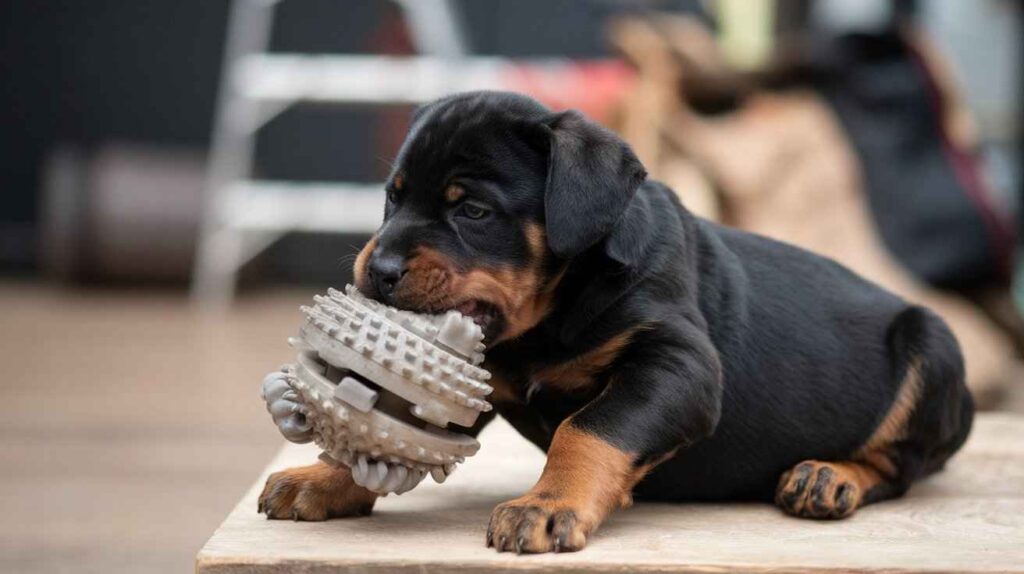
-
Did you know that wild dogs naturally seek out den-like spaces for security and comfort? Crate training taps into this instinct and provides your Rottweiler puppy with a similar sense of security.
Socialization: Raising a Well-Adjusted Rottie Rockstar
-
Did you know that Rottweilers were historically used as guard dogs and protectors? Proper socialization helps them channel their protective instincts appropriately and ensures they're friendly and approachable in non-threatening situations.
Okay, picture this: a Rottweiler puppy confidently strolling through a park, greeting other dogs with a wagging tail and a playful bow, calmly navigating a bustling sidewalk, and maybe even striking up a friendship with a friendly squirrel (okay, maybe not the squirrel part, but you get the idea!). That’s the power of socialization!
Puppy Parties and Playdates: The Importance of Early Interactions
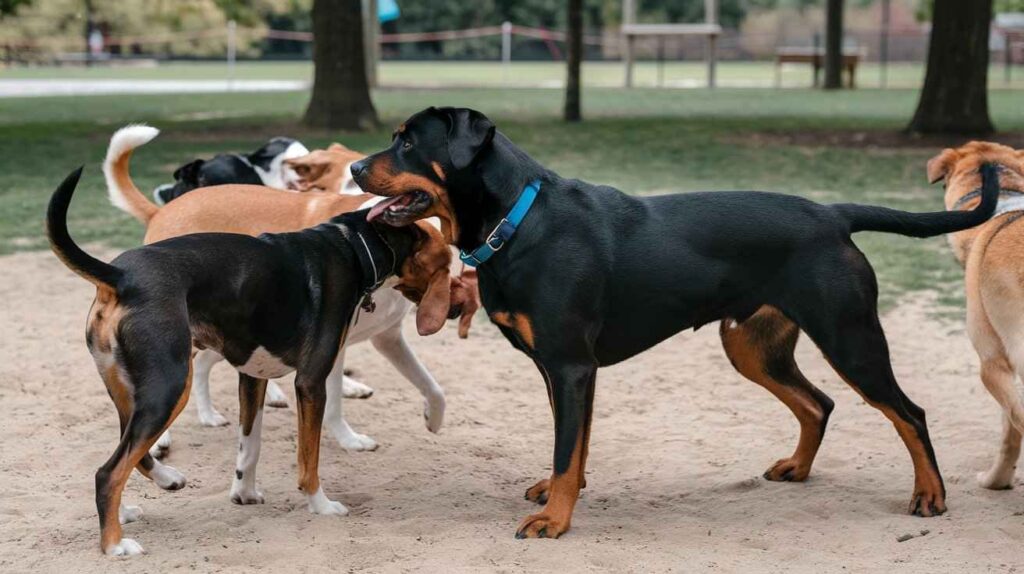
Socialization is like giving your Rottweiler puppy a crash course in how to be an awesome canine citizen. The early weeks are crucial for socialization, as explained in this position statement from the American Veterinary Society of Animal Behavior. And the earlier you start, the better. Puppyhood is a critical period for socialization, as their brains are like little sponges, soaking up all sorts of experiences and forming lifelong impressions.
- Puppy Parties: These supervised play sessions with other puppies are a fantastic way to teach your Rottie how to interact appropriately with other dogs. They learn important social cues, like how to play nicely and read body language.
- Playdates with Adult Dogs: Once your puppy is fully vaccinated, arrange playdates with friendly, well-socialized adult dogs. This helps them learn how to interact with dogs of different ages and temperaments.
- Meeting New People: Introduce your puppy to a variety of people, including children, adults, and people of different ethnicities and appearances. This helps them become comfortable and confident around all sorts of humans.
Exploring the World: Sights, Sounds, and Adventures
Socialization isn’t just about meeting other dogs and people; it’s about exposing your puppy to a wide range of experiences.
- Out and About: Take your puppy on walks in different environments, like parks, busy streets, and even pet-friendly stores. This helps them get used to different sights, sounds, and smells.
- Sensory Stimulation: Expose your puppy to different sounds, like car horns, sirens, and even the vacuum cleaner (a Rottweiler’s arch-nemesis!). This helps them become desensitized to noises that might otherwise startle them.
- Handling and Touch: Get your puppy used to being handled and touched all over, including their paws, ears, and mouth. This makes vet visits and grooming sessions much easier.
Why Socialization Matters:
- Confident Canine: A well-socialized Rottweiler is a confident Rottweiler. They’re less likely to be fearful or reactive in new situations, making them safer and more enjoyable companions.
- Happy and Well-Adjusted: Socialization helps your Rottie develop into a happy, well-adjusted adult who can navigate the world with ease.
- Preventing Behavioral Issues: Early socialization can help prevent behavioral problems like fear aggression or excessive barking.
Want more tips on socializing your Rottweiler puppy? Check out our complete guide: Rottweiler Puppy Training: Your First 6 Months (A Complete Guide)
Basic Obedience: Building a Foundation of Good Manners (and Maybe Preventing a Few "Oops" Moments)
Okay, let’s be real, those Rottweiler puppies are adorable, but they can also be little bundles of chaos. They’re like tiny, furry bulldozers with a knack for getting into mischief. That’s where obedience training comes in!
Starting with the Basics: Laying the Groundwork
Early obedience training is like giving your Rottweiler puppy a user manual for life. It teaches them essential skills, helps them understand boundaries, and sets the stage for a well-behaved and responsive companion.
- Why it Matters: Obedience training isn’t just about teaching your Rottie to sit and stay; it’s about building a strong foundation of communication and trust. It helps them understand what you expect from them, which can prevent behavioral issues down the road and keep them safe in various situations.
- Essential Commands: Start with those classic commands:
- “Sit”: This is a great foundation command that can be used in various situations, from greeting guests to preventing them from jumping on people.
- “Stay”: This command teaches your Rottie impulse control and can be helpful for keeping them safe in potentially dangerous situations, like near traffic or open doors.
- “Come”: This is arguably the most important command, as it can help prevent your Rottie from running off or getting into trouble.
Positive Reinforcement: Training with Treats and Cheers
Forget those old-school, harsh training methods. Positive reinforcement is the way to go! This means rewarding your Rottie for good behavior with praise, treats, or a favorite toy.
- Why it Works: Positive reinforcement makes training fun and motivating for your puppy. It helps them associate good behavior with positive experiences, making them more likely to repeat those behaviors.
- Consistency is Key: Be consistent with your commands and rewards. This helps your puppy understand what you expect from them and makes learning more efficient.
- Patience is a Virtue: Remember, puppies are still learning! Be patient and understanding, and celebrate those small victories along the way.
-
Training your Rottweiler can actually strengthen your bond! It's a great way to spend quality time together, build trust, and create a deeper connection with your furry friend.
Adult Rottweilers: Maintaining Those Magnificent Beasts (Engaging and Informal)
Okay, your Rottie’s no longer a clumsy, bitey puppy. They’ve blossomed into a magnificent beast of a dog – loyal, strong, and probably still a little bit goofy. But those adult Rotties have different needs than their younger selves, especially when it comes to keeping those powerful bodies fueled.
Adult Dog Food: Leveling Up Their Nutrition
Around 12-18 months, it’s time to transition your Rottweiler from puppy food to an adult formula. But with a gazillion options on the pet food aisle, how do you choose the right one for your Rottie?
- Activity Level: Is your Rottie a couch potato who enjoys leisurely strolls and epic naps? Or are they an athlete who lives for hikes, runs, and maybe even agility courses? Active dogs need more calories and protein than their more laid-back counterparts.
- Health Considerations: Does your Rottie have any specific health needs? Maybe they’re prone to allergies or have sensitive skin. Or perhaps they need a little extra joint support. There are specialized formulas for all sorts of needs, so talk to your vet about finding the best fit.
- Quality Ingredients: Just like you wouldn’t fuel your body with junk food, you don’t want to fuel your Rottie’s body with junk ingredients. Look for a food with high-quality animal protein as the first ingredient, and avoid those fillers and artificial additives.
Feeding Guidelines: Portion Control is Key
Rottweilers are big dogs with big appetites, but overfeeding can lead to obesity and a whole bunch of health problems. So, portion control is your best friend!
- Follow the Label (But Use Your Judgment): Start with the feeding guidelines on the dog food bag, but remember that those are just general recommendations. You might need to adjust the amount based on your Rottie’s individual needs, activity level, and metabolism.
- Two Square Meals: Most adult Rottweilers do well with two meals per day, spaced evenly throughout the day. This helps keep their energy levels stable and prevents those “hangry” outbursts (nobody wants to deal with a hangry Rottie!).
- Treats in Moderation: We all love to spoil our Rotties with treats, but those little snacks can add up quickly. Choose healthy, low-calorie treats and use them sparingly. You can also use a portion of their regular food as training treats.
Weight Management: Keeping Those Love Handles in Check
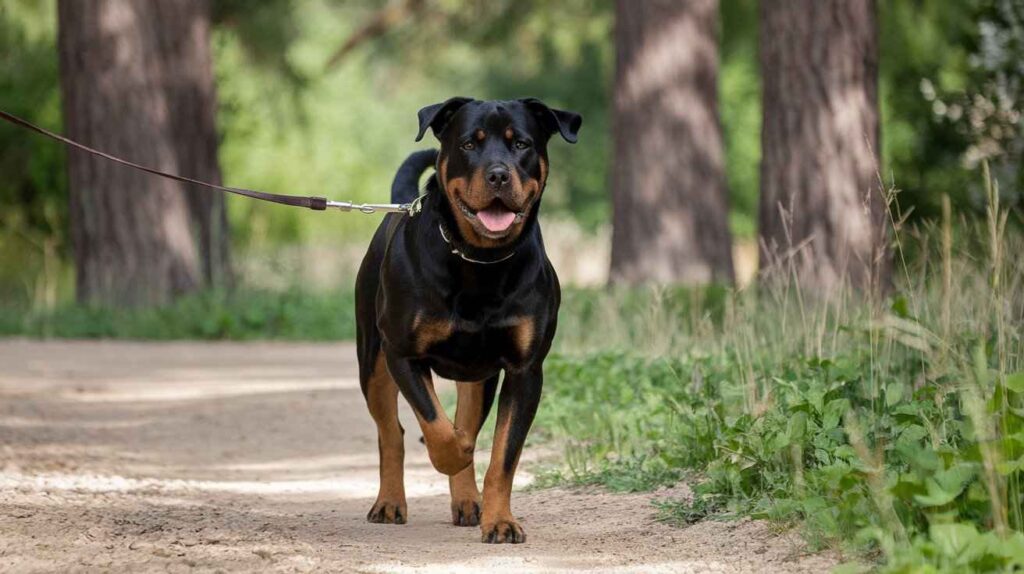
Okay, let’s be honest, those Rottie cuddles are even better when they’re not accompanied by a layer of extra fluff. But keeping your Rottweiler at a healthy weight is about more than just aesthetics; it’s crucial for their overall health and well-being.
- The Risks of Obesity: Excess weight puts extra stress on your Rottie’s joints, heart, and other organs. It can increase their risk of developing serious health problems like hip dysplasia, heart disease, and diabetes.
- Tips for a Trim Rottie: Regular exercise, portion control, and those healthy treat choices are your best weapons in the fight against Rottie weight gain. Also, keep an eye on their body condition. You should be able to feel their ribs easily, but they shouldn’t be overly prominent.
Food Allergies: When Their Tummy Throws a Tantrum
Just like humans, Rottweilers can have food allergies. And those allergies can manifest in all sorts of ways, from itchy skin and ear infections to digestive upset.
- Common Culprits: Some of the most common food allergens for Rottweilers include beef, chicken, dairy, and wheat.
- Spotting the Signs: If you notice your Rottie scratching excessively, having tummy troubles, or getting frequent ear infections, a food allergy might be the culprit.
- Working with Your Vet: If you suspect a food allergy, talk to your vet. They can help you identify the offending ingredient and recommend a hypoallergenic diet or an elimination diet to pinpoint the trigger.
My Rottie's Picky Palate:
My Rottweiler, Max, is a bit of a foodie. He’s got a refined palate (for a dog, anyway) and turns his nose up at anything that doesn’t meet his high standards. We’ve gone through a whole buffet of dog food brands before finding one that he actually enjoys. But hey, when you’re as awesome as Max, you deserve to have your culinary preferences catered to, right?
Grooming: Keeping Your Rottie Looking (and Smelling) Their Best
Rottweilers aren’t exactly known for being pristine, perfectly-coiffed pups. They’re more the “roll-in-the-mud-and-then-shake-it-off” type. But even these rugged pups need some grooming love to stay healthy and comfortable. And hey, who doesn’t love a clean, fresh-smelling Rottie cuddle?
Brushing: The Fur-ocious Battle Against Shedding
Remember that double coat we talked about? Yeah, it sheds. A lot. But don’t worry, regular brushing is your secret weapon in the war against those tumbleweeds of fur taking over your house.
- Brushing Routine: Aim to brush your Rottweiler a couple of times a week to help manage shedding, prevent mats, and keep their coat healthy and shiny.
- Brush Choices: A slicker brush or a bristle brush works great for their outer coat, while a rake or undercoat rake can help tackle that fluffy undercoat during shedding season (you know, those times of the year when it seems like your Rottie is trying to create a whole new dog out of fur).
Bathing: Not Too Often, But Just Right
Rottweilers don’t need frequent baths. Over-bathing can strip their coat of its natural oils and cause dryness. Aim for a bath every 2-3 months, or more often if they decide to take a mud bath (because, let’s be real, some Rotties just can’t resist a good mud puddle).
- Shampoo Selection: When you do bathe them, use a gentle dog shampoo specifically formulated for their coat type. And don’t forget to rinse thoroughly! Nobody likes that itchy, soapy residue.
Nail Care: Clipping Those Claws of Doom
Those Rottweiler nails can get long and sharp, which can be uncomfortable for both your Rottie and your furniture (and your shins!). Regular nail trims are essential.
- Trimming Tips: Use a guillotine-style or scissor-style nail clipper designed for dogs. Be careful not to cut the quick (the pink part of the nail that contains blood vessels and nerves). If you’re unsure about how to trim your Rottie’s nails, ask your vet or a groomer for guidance.
Ear Care: Keeping Those Ears Clean and Happy
Rottweilers’ floppy ears can trap moisture and debris, making them prone to ear infections. Regular ear cleaning helps prevent those icky infections and keeps those ears healthy.
- Cleaning Routine: Check your Rottie’s ears weekly for any signs of redness, swelling, or discharge. Clean them with a dog-specific ear cleaner and cotton balls. Avoid using cotton swabs, as they can push debris further into the ear canal.
Dental Care: Those Chompers Need Love Too!
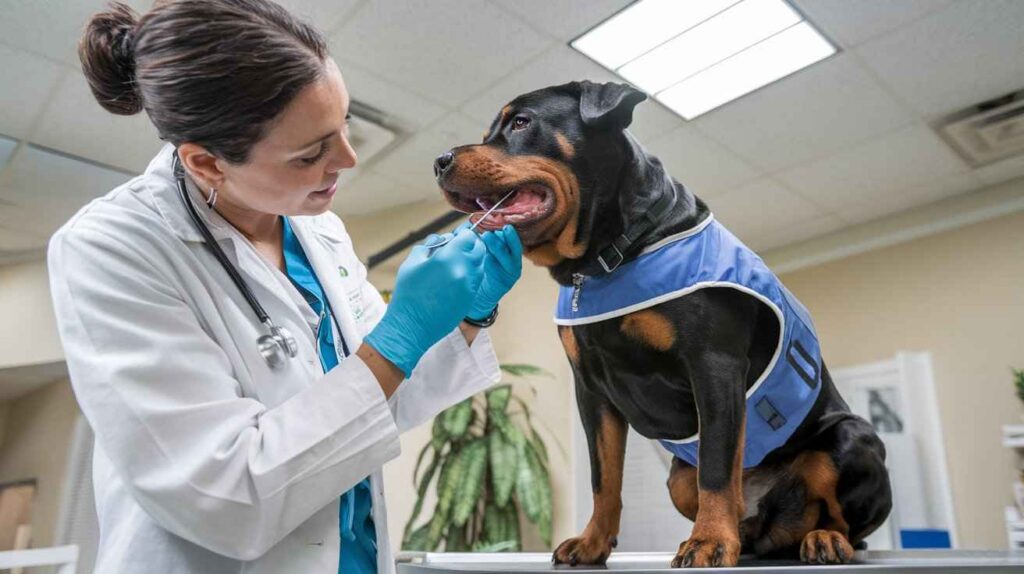
We’ve already talked about dental care, but it’s worth repeating! Brushing your Rottweiler’s teeth regularly can help prevent gum disease, tooth decay, and that dreaded doggie breath.
- Brushing Tips: Use a dog-specific toothbrush and toothpaste (never human toothpaste!), and aim to brush their teeth at least a few times a week. You can also offer dental chews and treats to help keep those pearly whites clean.
-
Regular grooming isn't just about keeping your Rottweiler looking good; it's an important part of their overall health care routine. It helps prevent skin problems, ear infections, and dental disease, and it's a great way to bond with your furry friend.
Senior Rottweilers: The Golden Years
Seeing your Rottweiler age can be bittersweet, but it’s also a time to cherish the special bond you’ve built and adapt your care to ensure their comfort and happiness in their golden years. We’ll explore how to provide the best care for your senior Rottie in the next section.
As your Rottweiler enters their senior years, it’s time to adjust their care to meet their changing needs. Think of it like upgrading their lifestyle to first-class!
Diet: Easy on the Tummy, Good for the Body
Those senior Rotties might not have the same digestive firepower as they did in their younger days. Switching to a senior-specific diet can make a big difference.
- Easier Digestion: Senior dog food formulas are often easier to digest, with higher-quality ingredients and sometimes even prebiotics and probiotics to support gut health.
- Joint Support: Many senior formulas include glucosamine and chondroitin, which can help support joint health and mobility.
- Other Supplements: Depending on your Rottie’s individual needs, your vet might recommend additional supplements, such as omega-3 fatty acids for skin and coat health or antioxidants to support cognitive function.
Exercise: Slowing Down, Not Stopping
Just because your Rottie is getting older doesn’t mean they should become a couch potato! Regular exercise is still crucial for maintaining their physical and mental health, but it’s important to adapt the activities to their changing abilities.
- Low-Impact is Key: Think gentle walks, swimming (if they enjoy it), or even some playtime in the yard. Avoid those high-impact activities that could put extra stress on their joints.
- Listen to Your Rottie: Pay attention to their cues. If they seem tired or reluctant to exercise, it’s time to take a break or switch to a less strenuous activity.
Comfort and Support: Making Life Easier

As your Rottie ages, they might need a little extra help getting around and staying comfortable.
- Orthopedic Beds: A comfy orthopedic bed can provide support for aging joints and help your Rottie get a good night’s sleep.
- Ramps and Stairs: If your Rottie has trouble navigating stairs or getting onto furniture, ramps or pet stairs can make their life easier.
- Joint Supplements: Joint supplements, like glucosamine and chondroitin, can help improve mobility and reduce joint pain.
Mental Stimulation: Keeping Those Minds Sharp
Even in their golden years, Rottweilers need mental stimulation to stay happy and engaged.
- Puzzle Toys: Puzzle toys provide a fun and challenging way for your Rottie to use their brains and earn those tasty treats.
- Gentle Training: Continue with basic obedience training or even teach them new tricks. This helps keep their minds sharp and strengthens your bond.
- Social Interaction: Make sure your senior Rottie still gets plenty of social interaction with you, other family members, and even friendly dogs. Socialization is important for their emotional well-being.
-
Senior Rottweilers can still enjoy a high quality of life with the right care and support. By adapting their routine and providing them with the love and attention they need, you can help them thrive in their golden years.
Common Health Issues in Senior Rottweilers: Navigating the Golden Years with Grace
As our Rottweilers enter their golden years, they might face some health challenges that come with age. But with awareness, proactive care, and a whole lot of love, we can help them navigate these challenges and enjoy a fulfilling life, even as they slow down a bit.
Arthritis: Those Aching Joints
Just like humans, Rottweilers can develop arthritis as they age. This degenerative joint disease causes pain, stiffness, and decreased mobility.
- Prevalence: Arthritis is quite common in senior Rottweilers, especially those with a history of hip or elbow dysplasia.
- Managing the Discomfort: While there’s no cure for arthritis, there are ways to manage the pain and improve your Rottie’s quality of life. These include:
- Medications: Your vet might prescribe pain relievers or anti-inflammatory medications to help manage pain and inflammation.
- Supplements: Joint supplements, such as glucosamine and chondroitin, can help support joint health and mobility.
- Physical Therapy: Gentle exercises and physical therapy can help maintain joint flexibility and muscle strength.
- Weight Management: Keeping your senior Rottie at a healthy weight can significantly reduce stress on their joints.
- Comfortable Living: Provide your Rottie with a comfortable bed, soft bedding, and easy access to their favorite spots. Ramps or pet stairs can help them navigate stairs or furniture.
Cognitive Decline: When Those Senior Moments Become More Frequent
As Rottweilers age, they might experience some cognitive decline, similar to dementia in humans. This can lead to changes in behavior, such as confusion, disorientation, altered sleep patterns, and changes in social interaction.
- Supporting Their Mental Well-being: While cognitive decline is a natural part of aging, there are ways to support your Rottie’s mental health:
- Mental Stimulation: Keep their minds active with puzzle toys, gentle training, and social interaction.
- Routine and Consistency: Maintain a consistent daily routine to provide a sense of security and predictability.
- Environmental Enrichment: Provide a safe and stimulating environment with plenty of opportunities for exploration and interaction.
- Medication: In some cases, your vet might recommend medication to help manage cognitive decline.
Other Age-Related Conditions:
Senior Rottweilers might also be more prone to other health issues, such as:
- Cancer: Certain types of cancer, like lymphoma and osteosarcoma, are more common in older dogs.
- Heart Disease: Heart conditions, such as dilated cardiomyopathy (DCM), can become more prevalent with age.
- Kidney and Liver Disease: These organs can also be affected by age-related decline.
- Dental Problems: Dental disease is common in senior dogs and can lead to pain, infection, and even difficulty eating.
Regular veterinary checkups are crucial for senior Rottweilers. These checkups allow your vet to monitor your Rottie’s health, detect any potential problems early on, and provide appropriate treatment and support to ensure they enjoy their golden years to the fullest.
To delve deeper into Rottweiler health and preventative care, check out our comprehensive article: Rottweiler Health 101: A Guide to Common Issues & Preventative Care
Conclusion: The Rottweiler Journey – Fur, Drool, and a Whole Lotta Love
Wow, we’ve covered a lot! From navigating those puppy piranha teeth to conquering the Great Rottie Shed-pocalypse and maybe even mastering the art of doggy dental hygiene, we’ve explored the ins and outs of Rottweiler care.
But caring for a Rottweiler is about so much more than just the practical stuff. It’s about those heart-melting cuddles, those goofy grins that can light up a room, and the unwavering loyalty that makes them such incredible companions.
The Rewards of Responsible Care:
Caring for a Rottweiler is a journey filled with laughter, adventure, and maybe a few muddy paw prints on the carpet. It’s about those joyful moments of playing fetch in the park, those quiet evenings snuggled up on the couch, and those heartwarming displays of love and devotion that only a Rottie can provide. By investing time and effort in their care, you’re not just keeping them healthy and happy; you’re strengthening that incredible bond and creating memories that will last a lifetime.
A Final Thought:
Rottweilers are truly magnificent creatures. They’re strong, loyal, intelligent, and full of love. Let’s cherish every stage of their lives, from those clumsy puppy days to those wise and gentle senior years. By providing them with the care and attention they deserve, we can ensure that they live long, fulfilling lives filled with joy, adventure, and maybe just a little bit of drool. After all, isn’t that what being a Rottie owner is all about?
FAQs: Your Burning Questions Answered!
1. How often should I groom my Rottweiler?
Answer: Brushing 2-3 times a week is usually sufficient, but more frequent brushing might be needed during shedding season. Bathing can be done every 2-3 months, or as needed.
2. What kind of food should I feed my Rottweiler puppy?
Answer: Choose a high-quality large-breed puppy food that's AAFCO-approved to support their rapid growth and development.
3. How can I prevent bloat in my Rottweiler?
Answer: Feed smaller, more frequent meals, avoid strenuous exercise after eating, and consider using slow-feed bowls or elevated food bowls.
4. What are the signs of a food allergy in a Rottweiler?
Answer: Food allergies can cause itchy skin, digestive upset, and ear infections. Consult your vet if you suspect a food allergy.
5. How much exercise does a senior Rottweiler need?
Answer: Senior Rottweilers still need regular exercise, but it should be adapted to their age and physical condition. Shorter walks, swimming, and gentle play are good options.


